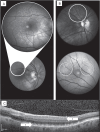The Crosstalk Between Amyloid-β, Retina, and Sleep for the Early Diagnosis of Alzheimer's Disease: A Narrative Review
- PMID: 39114553
- PMCID: PMC11305848
- DOI: 10.3233/ADR-230150
The Crosstalk Between Amyloid-β, Retina, and Sleep for the Early Diagnosis of Alzheimer's Disease: A Narrative Review
Abstract
Alzheimer's disease (AD) is the most common type of dementia, which is characterised by progressive memory loss and accumulation of hallmark markers amyloid-β (Aβ) and neurofibrillary tangles in the diseased brain. The current gold standard diagnostic methods have limitations of being invasive, costly, and not easily accessible. Thus, there is a need for new avenues, such as imaging the retina for early AD diagnosis. Sleep disruption is symptomatically frequent across preclinical and AD subjects. As circadian activity, such as the sleep-wake cycle, is linked to the retina, analysis of their association may be useful additions for achieving predictive AD diagnosis. In this narrative review, we provide an overview of human retina studies concerning the deposition of Aβ, the role of the retina in sleep-wake cycle, the disruption of sleep in AD, and to gather evidence for the associations between Aβ, the retina, and sleep. Understanding the mechanisms behind the associations between Aβ, retina, and sleep could assist in the interpretation of retinal changes accurately in AD.
Keywords: Alzheimer’s disease; amyloid; dementia; retina; sleep.
© 2024 – The authors. Published by IOS Press.
Conflict of interest statement
The authors have no conflict of interest to report.
Figures



Similar articles
-
Amyloid Beta Immunoreactivity in the Retinal Ganglion Cell Layer of the Alzheimer's Eye.Front Neurosci. 2020 Jul 31;14:758. doi: 10.3389/fnins.2020.00758. eCollection 2020. Front Neurosci. 2020. PMID: 32848548 Free PMC article.
-
Circadian and sleep dysfunction in Alzheimer's disease.Ageing Res Rev. 2020 Jul;60:101046. doi: 10.1016/j.arr.2020.101046. Epub 2020 Apr 16. Ageing Res Rev. 2020. PMID: 32171783 Review.
-
Sleep in Alzheimer's Disease - Beyond Amyloid.Neurobiol Sleep Circadian Rhythms. 2017 Jan;2:4-14. doi: 10.1016/j.nbscr.2016.08.002. Epub 2016 Aug 10. Neurobiol Sleep Circadian Rhythms. 2017. PMID: 28217760 Free PMC article.
-
Alzheimer's disease.Subcell Biochem. 2012;65:329-52. doi: 10.1007/978-94-007-5416-4_14. Subcell Biochem. 2012. PMID: 23225010 Review.
-
Deciphering the Interacting Mechanisms of Circadian Disruption and Alzheimer's Disease.Neurochem Res. 2021 Jul;46(7):1603-1617. doi: 10.1007/s11064-021-03325-x. Epub 2021 Apr 19. Neurochem Res. 2021. PMID: 33871799 Review.
Cited by
-
Stem cell therapy in Alzheimer's disease: current status and perspectives.Front Neurosci. 2024 Nov 21;18:1440334. doi: 10.3389/fnins.2024.1440334. eCollection 2024. Front Neurosci. 2024. PMID: 39640295 Free PMC article. Review.
-
"Advances in biomarker discovery and diagnostics for alzheimer's disease".Neurol Sci. 2025 Jun;46(6):2419-2436. doi: 10.1007/s10072-025-08023-y. Epub 2025 Feb 1. Neurol Sci. 2025. PMID: 39893357 Review.
-
Sleep structure of short-term insomnia disorder with mild cognitive impairment in older adults and their correlation with cognitive function: a case-control study.Front Aging Neurosci. 2025 Jan 3;16:1507285. doi: 10.3389/fnagi.2024.1507285. eCollection 2024. Front Aging Neurosci. 2025. PMID: 39831086 Free PMC article.
References
-
- Government A (2023) Dementia in Australia. Australian Institute of Health and Welfare.
-
- Okonkwo OC, Schultz SA, Oh JM, Larson J, Edwards D, Cook D, Koscik R, Gallagher CL, Dowling NM, Carlsson CM, Bendlin BB, LaRue A, Rowley HA, Christian BT, Asthana S, Hermann BP, Johnson SC, Sager MA (2014) Physical activity attenuates age-related biomarker alterations in preclinical AD. Neurology 83, 1753–1760. - PMC - PubMed
-
- Shah TM, Weinborn M, Verdile G, Sohrabi HR, Martins RN (2017) Enhancing cognitive functioning in healthy older adults: A systematic review of the clinical significance of commercially available computerized cognitive training in preventing cognitive decline. Neuropsychol Rev 27, 62–80. - PubMed
Publication types
LinkOut - more resources
Full Text Sources
Research Materials

